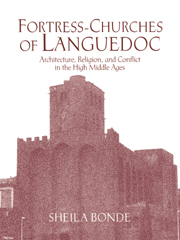Book contents
- Frontmatter
- Contents
- List of illustrations
- Acknowledgments
- Introduction
- 1 Ecclesiastical Fortification in the Middle Ages
- 2 The Larger Context: Languedoc in the Twelfth Century
- 3 The Buildings and the Documents: Maguelone, Agde, and Saint-Pons-de-Thomières
- 4 The Manning and Operation of Fortress-Churches
- 5 The Architectural Context: Sources and Parallels
- Conclusion
- Appendixes
- Tables
- Abbreviations
- Notes
- Bibliography
- Illustration credits
- Index
Introduction
Published online by Cambridge University Press: 02 November 2009
- Frontmatter
- Contents
- List of illustrations
- Acknowledgments
- Introduction
- 1 Ecclesiastical Fortification in the Middle Ages
- 2 The Larger Context: Languedoc in the Twelfth Century
- 3 The Buildings and the Documents: Maguelone, Agde, and Saint-Pons-de-Thomières
- 4 The Manning and Operation of Fortress-Churches
- 5 The Architectural Context: Sources and Parallels
- Conclusion
- Appendixes
- Tables
- Abbreviations
- Notes
- Bibliography
- Illustration credits
- Index
Summary
The records of church councils bear witness to the presence of ecclesiae incastellatae across the medieval landscape. The relatively common medieval practice of fortifying churches may appear paradoxical to our modern sensibilities, which tend to regard castles as secular, functional creations of feudalism, and churches as more symbolic expressions of medieval spirituality. Indeed, castles and churches are seldom considered together in the literature on medieval architecture and are normally examined by different scholars. Contrary to the rather arbitrary division of modern scholarship, however, the two sets of monuments were often closely related, sharing common patrons, technological innovations, and designs. Evidence of this association is readily available in contemporary texts as well as in surviving buildings. Patrons responsible for the construction of both military and ecclesiastical buildings can be identified from documentary sources. Gundulf, bishop of Rochester in the late eleventh century, for example, supervised the construction of both the Tower of London and Rochester Cathedral. His contemporary, Benno II, bishop of Osnabrück, is also credited with both castle and church projects. The forms and techniques of single-nave plan, thick-wall construction, intramural gallery passages, stair vises, machicolation, and crenellation, are often shared by castle and church buildings.
Nowhere can this fusion of the secular and religious realms be seen more clearly than in the twelfth-century fortified churches of Maguelone, Agde, and Saint-Pons-de-Thomières. As hybrid fortress-cathedrals and abbeys, these buildings have seldom been incorporated into the history of either ecclesiastical or military architecture.
- Type
- Chapter
- Information
- Fortress-Churches of LanguedocArchitecture, Religion and Conflict in the High Middle Ages, pp. 1 - 10Publisher: Cambridge University PressPrint publication year: 1994
- 2
- Cited by



